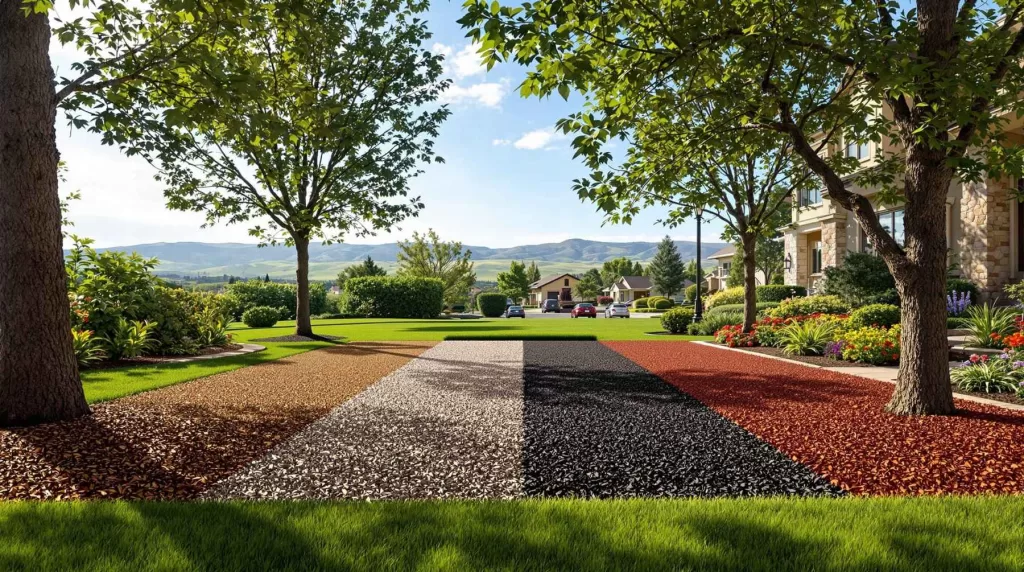
What Type of Mulch is Best for Castle Pines Landscapes?
Introduction Choosing the right mulch is more than just a visual decision — it’s a key part of protecting your plants, conserving water, and keeping
Castle Pines, Colorado, sits at an average elevation of approximately 6,400 feet above sea level, making it one of the higher-elevation communities in Douglas County. This elevated position affects everything from plant selection and irrigation planning to grading and erosion control. Landscapers must factor in high UV exposure, cooler night temperatures, and shorter growing seasons when designing for this region. Combined with the area’s natural hills, ridges, and varying terrain, elevation is not just a backdrop—it’s a foundational element in successful outdoor design here. If you’re looking for expert help designing for elevation, our Castle Pines landscaping services are tailored for the unique terrain in this area.
Castle Pines occupies a unique transitional zone between the foothills of the Front Range and Colorado’s eastern plains, creating diverse terrain and dramatic vistas. At around 6,400 feet in elevation, the town experiences:
Compared to nearby towns like Parker or Highlands Ranch, Castle Pines typically offers more dramatic grade changes and more natural terrain, making elevation management a more prominent part of landscape planning.
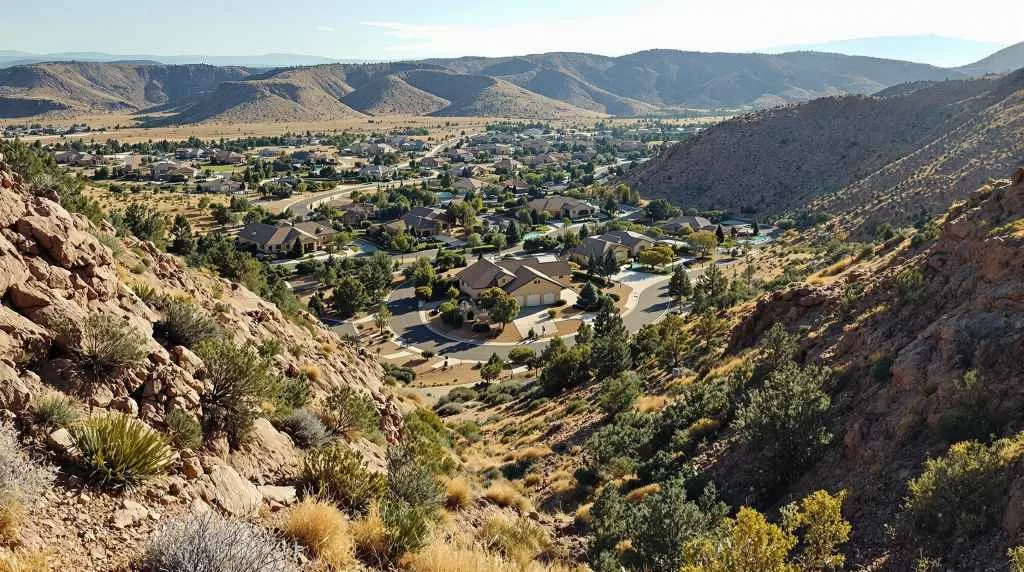
Not all Castle Pines neighborhoods sit at the same altitude. The town’s rolling layout means that even within a few square miles, elevation can vary in ways that influence drainage, planting, and hardscaping. For example:
These subtle differences can dramatically affect what works—and what doesn’t—when designing a landscape in each neighborhood.
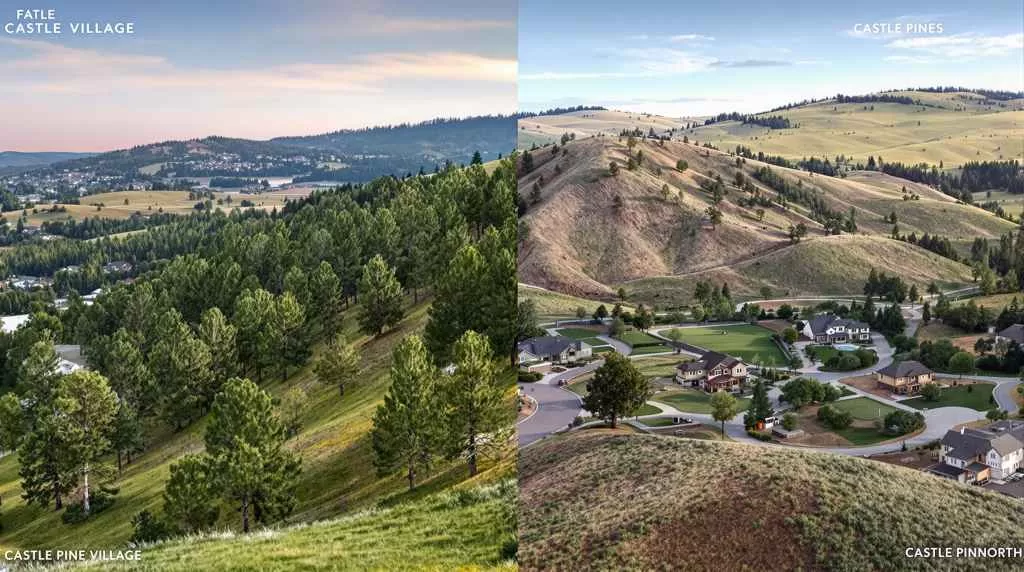
Castle Pines is defined not just by its height, but by its distinct geology. The area features:
These features, shaped by elevation and erosion over time, create a setting where every landscape design must be uniquely adapted to the land it occupies. Whether you’re stabilizing a slope or choosing the right plants for a rocky ledge, geology and elevation work hand-in-hand in Castle Pines.
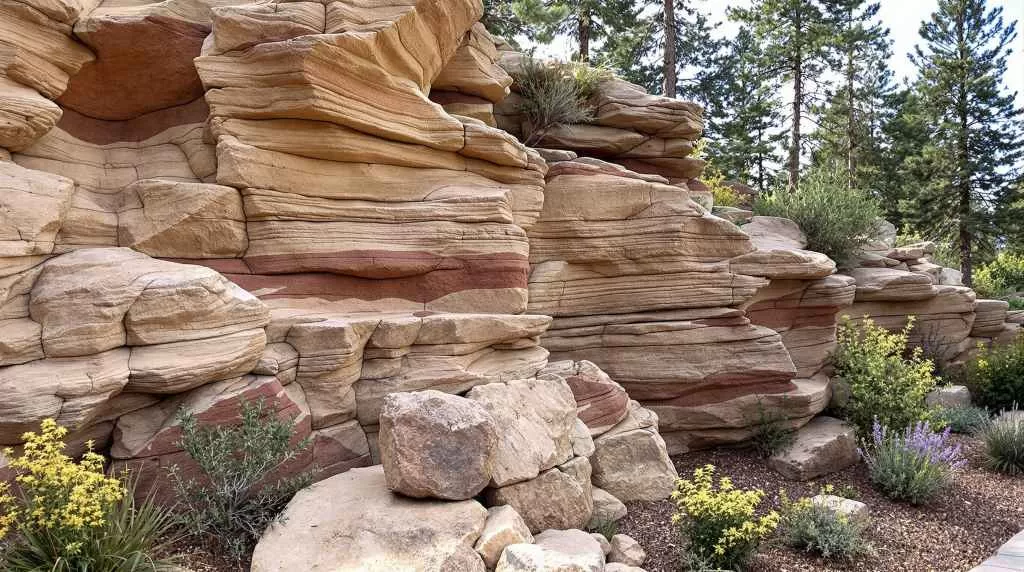
H2: The Role of High Altitude in Plant Selection
At approximately 6,400 feet above sea level, Castle Pines sits in a high-altitude environment that significantly affects what types of plants will thrive. The combination of intense sunlight, cooler temperatures, thinner air, and variable moisture levels means that not all plants that grow well in Denver or lower elevations will perform well here. Homeowners and landscape designers must prioritize cold-hardy, drought-resistant, and UV-tolerant plant species that can adapt to these unique environmental stressors.
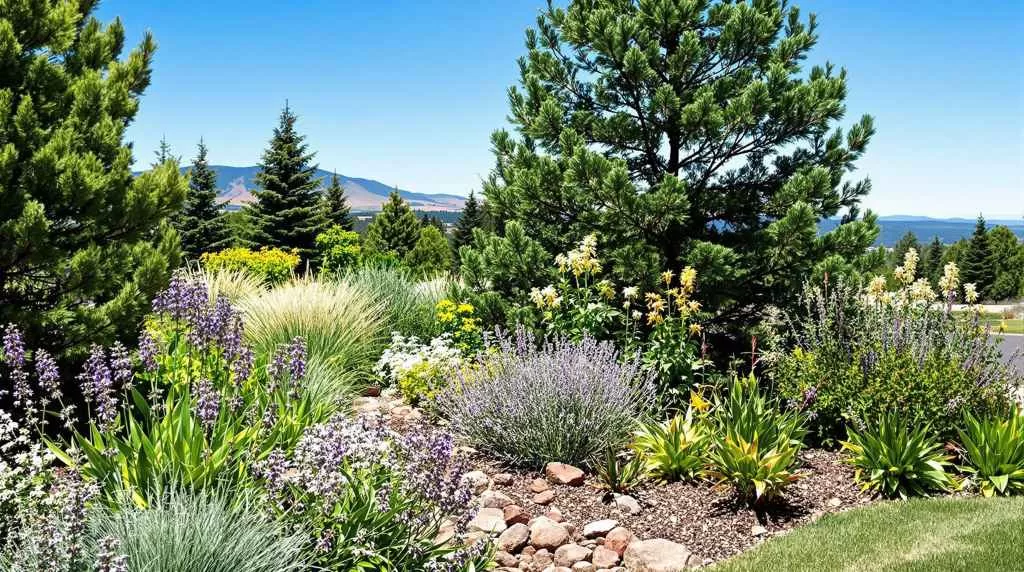
Plants in Castle Pines need to endure long winters and sudden temperature drops, even in late spring or early fall. The growing season is not only shorter but also more unpredictable, making plant resilience a top priority in any landscape plan.
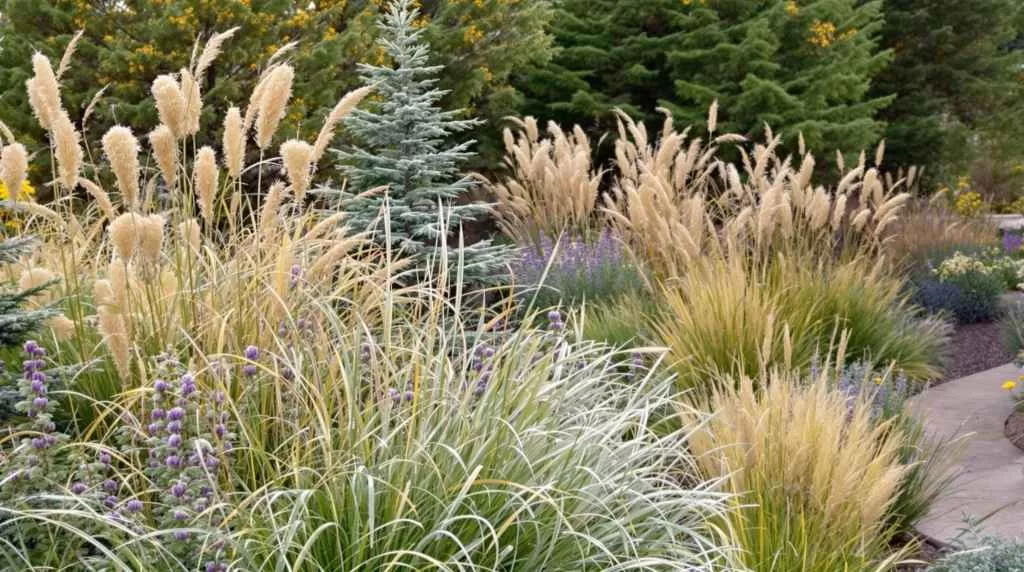
Because of the town’s elevation, Castle Pines experiences a delayed spring and an early onset of fall, meaning the window for planting and growing is considerably narrower than at lower elevations. Most plants have a window of roughly 100–120 frost-free days, so selections must grow quickly, mature efficiently, and be able to withstand late-spring cold snaps or early autumn frosts.
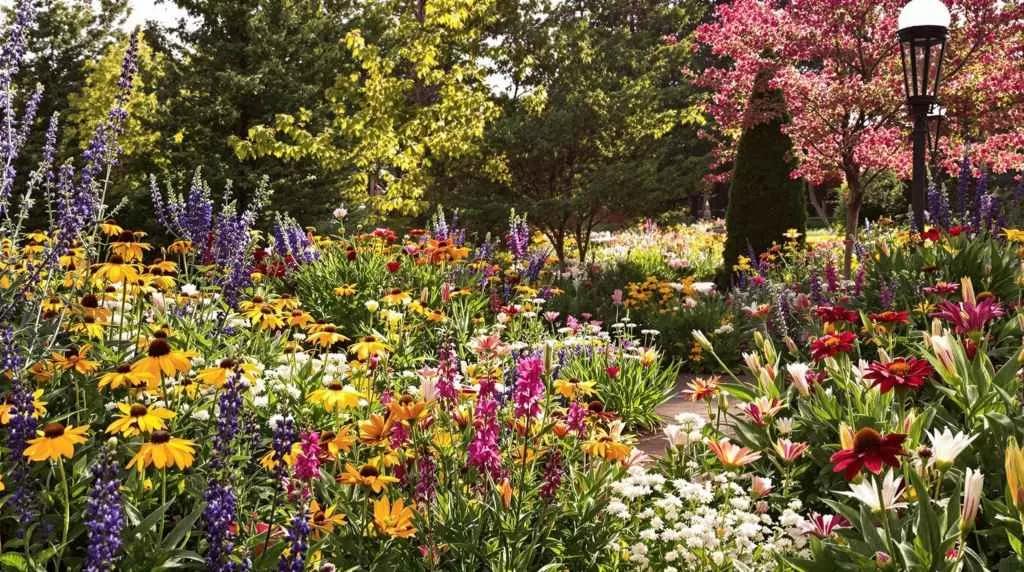
Higher elevation also brings the risk of unexpected freezes, sometimes occurring well into May or returning as early as September. This can shock tender plants, damage young shoots, and reduce flowering or harvest potential. Choosing plants rated for Zone 5 or lower is often necessary, and using frost blankets or cold frames during shoulder seasons can help extend viability.
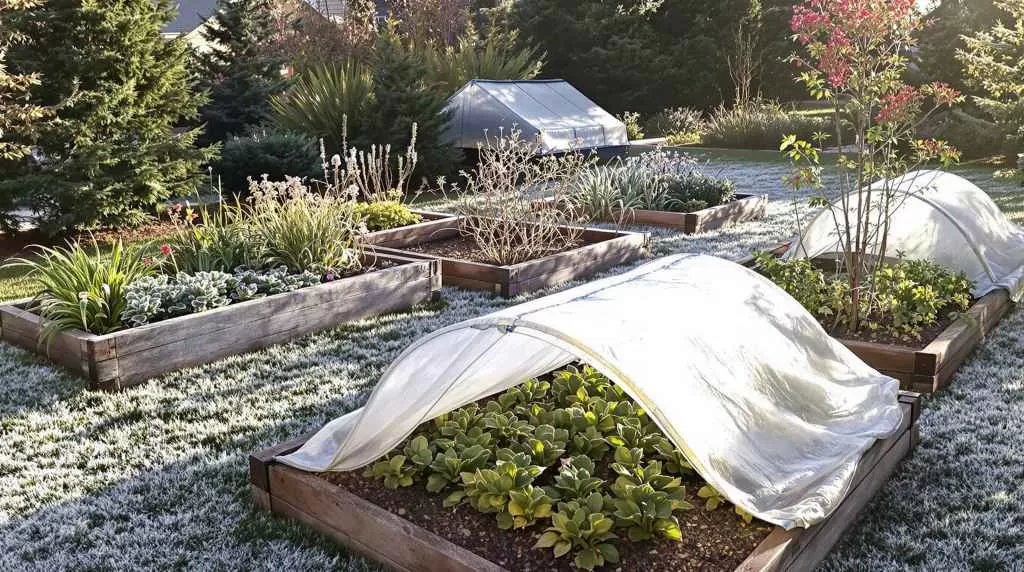
At higher altitudes like Castle Pines, UV radiation is significantly more intense, increasing the risk of leaf scorch, sunburn, and pigment fading in many plant species. While more sunlight can enhance growth for sun-loving plants, it also means that delicate or shade-loving varieties may struggle. This added exposure calls for careful placement, use of partial-shade structures, and selection of plants with thicker, waxier leaves that are naturally more UV-resistant.
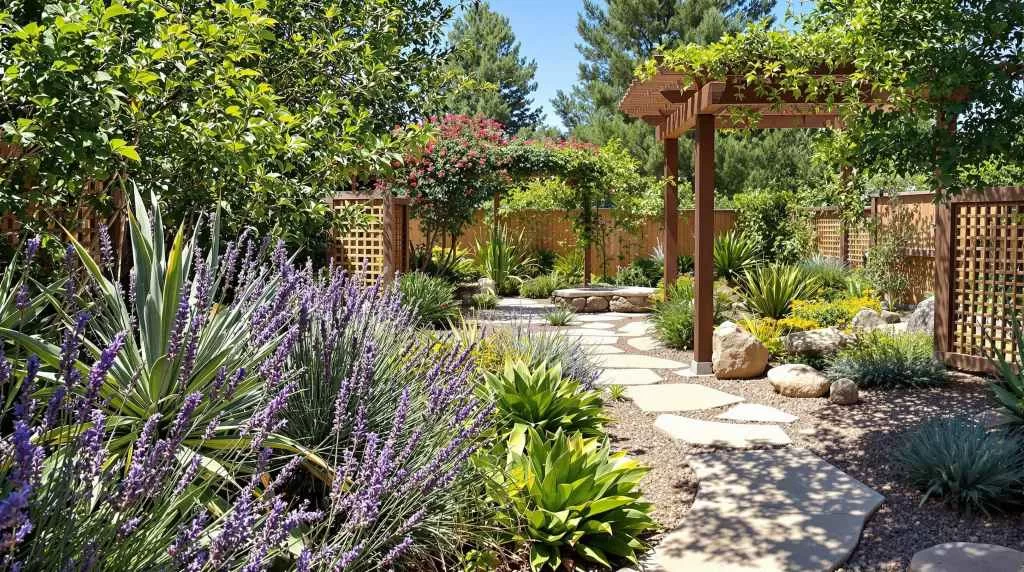
In Castle Pines, elevation changes are common even within a single residential lot, and these slopes can have a significant effect on how a yard functions. Grading directly impacts water flow, safety, and usability, making it a crucial element in landscape planning. Whether you’re working with a gentle incline or a steep hillside, thoughtful slope management is essential to create outdoor spaces that are not only beautiful but also accessible and practical for daily use. Learn how our Castle Pines landscaping team creates usable outdoor spaces on sloped lots.
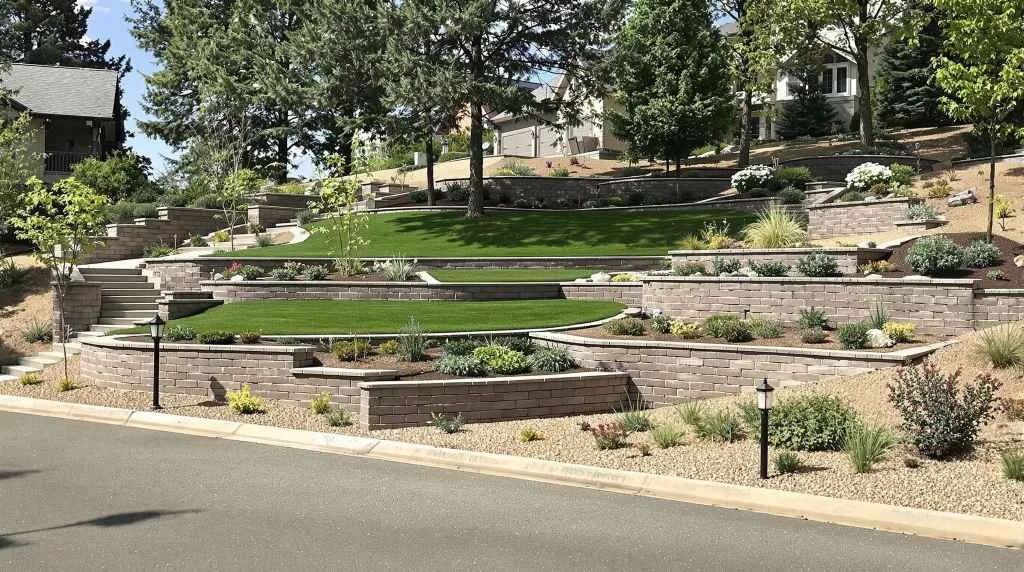
Sloped terrain limits the amount of level, usable space available for key outdoor features. Without proper grading or design adaptation, homeowners may struggle to create functional areas for relaxation, play, or movement. This makes it important to assess the degree of slope early in the design process to determine where modifications or reinforcements are needed.

Flat areas are critical for anything that involves seating, movement, or play. Patios, pergolas, fire pits, children’s play zones, and garden beds all benefit from level surfaces that enhance safety and comfort. Sloped areas often need to be excavated, retained, or terraced to create these essential zones and prevent shifting or erosion.
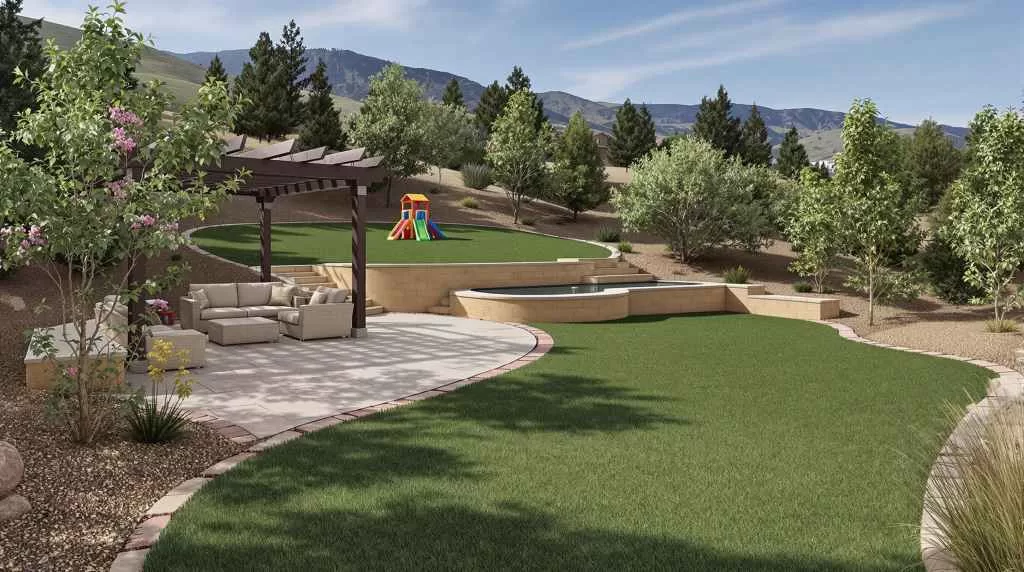
Navigating elevation changes requires careful planning, especially for older adults, children, or anyone with mobility concerns. Steps and ramps must be constructed with code-compliant rise and run, as well as slip-resistant materials. Including handrails, lighting, and resting points on steeper slopes can make a landscape far more inclusive and user-friendly.
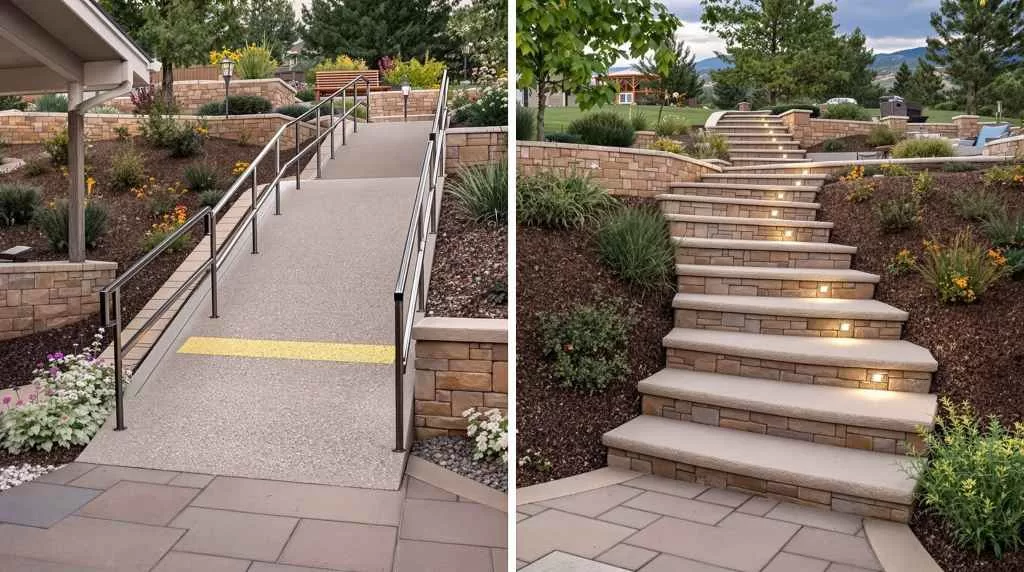
While slopes create challenges, they also open the door to stunning visual design. A sloped yard can be transformed using:
These elevation-enhanced features give Castle Pines properties a layered, resort-like appearance that turns challenging terrain into a design asset. Our team specializes in elevation-smart landscaping in Castle Pines to turn slopes into stunning focal points.
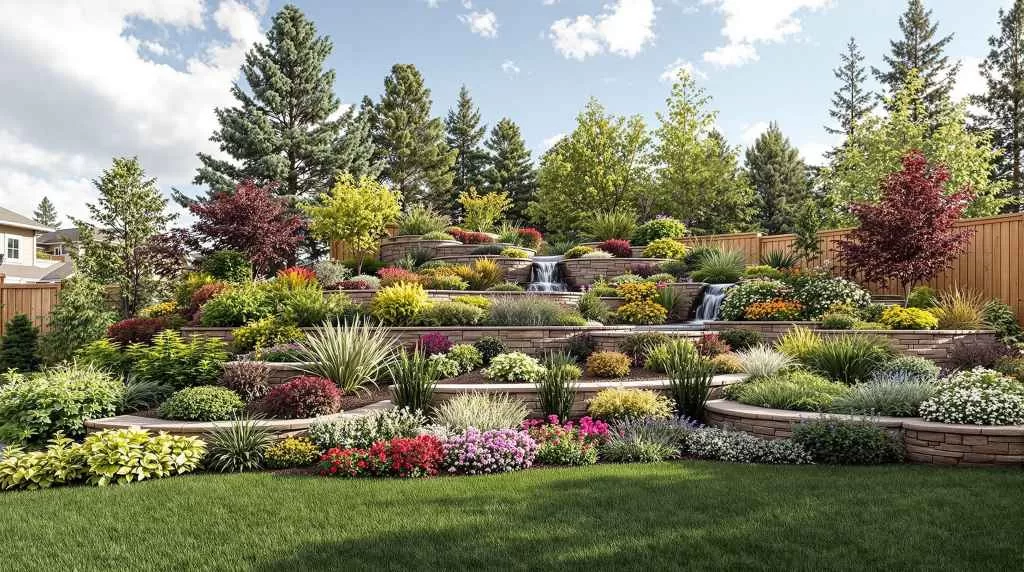
Castle Pines’ elevated terrain often comes with dense clay soils, shallow bedrock, and uneven water distribution. These factors create distinct challenges when it comes to both planting and drainage. Elevated areas tend to shed water more quickly due to gravity, but clay-heavy soils often retain moisture unevenly, leading to poor infiltration in some areas and oversaturation in others. To maintain healthy landscapes, homeowners must address both the physical makeup of the soil and how water naturally moves across sloped terrain.
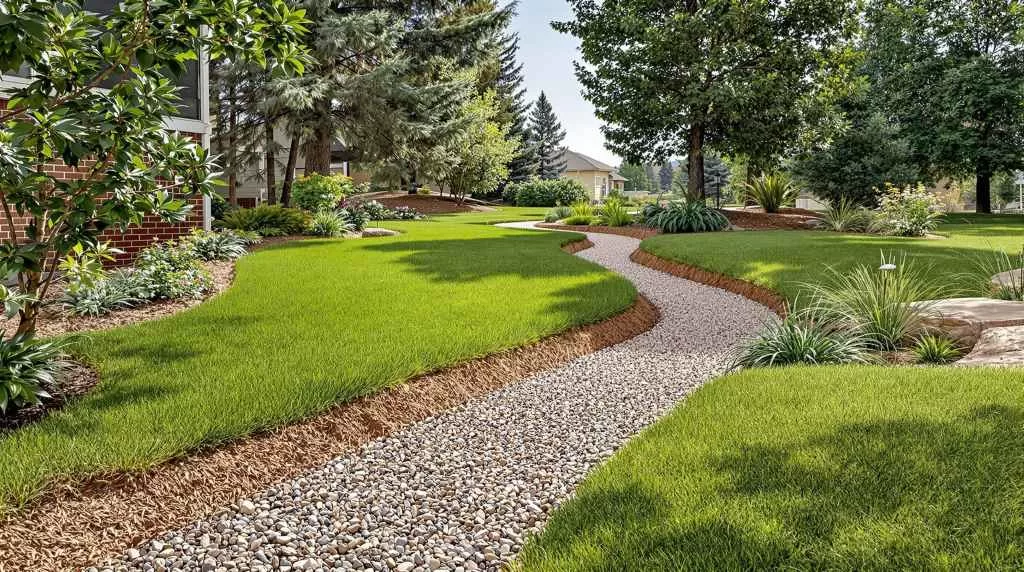
When water flows across an incline, it can carry topsoil and nutrients with it—especially after heavy rain or snowmelt. Without the right protective measures, this leads to bare patches, root exposure, and sediment buildup at the bottom of slopes. Castle Pines landscapes benefit from layered erosion control techniques that slow water movement and hold the soil in place naturally.
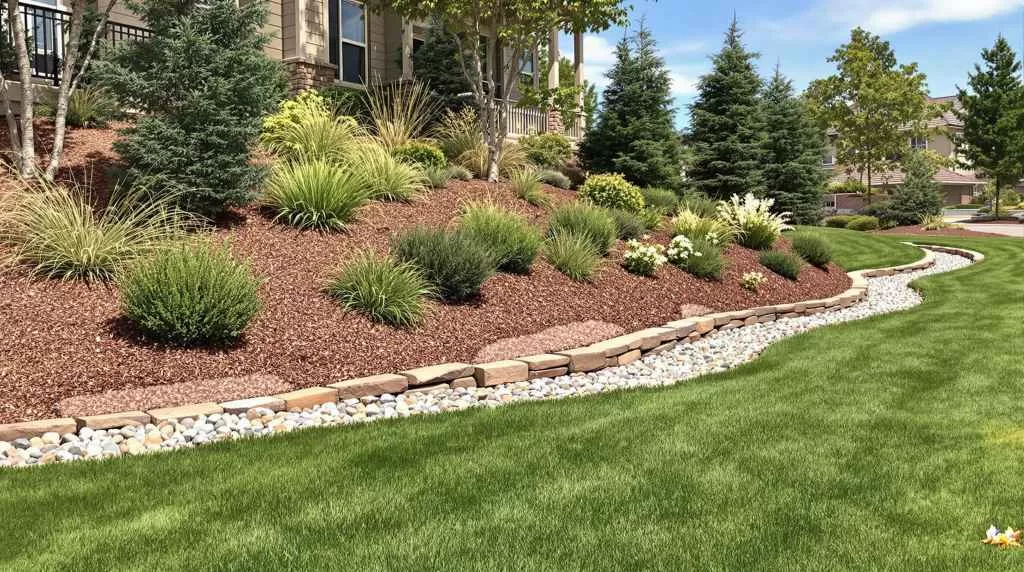
On sloped or elevated areas, traditional wood mulch can easily wash away or shift, especially during storms. In Castle Pines, it’s better to use heavier bark nuggets, rock mulch, or bonded materials that stay in place. Groundcovers like creeping juniper, ice plant, or sedum are excellent choices, as they spread across the soil surface, provide year-round coverage, and anchor the soil with dense root systems.
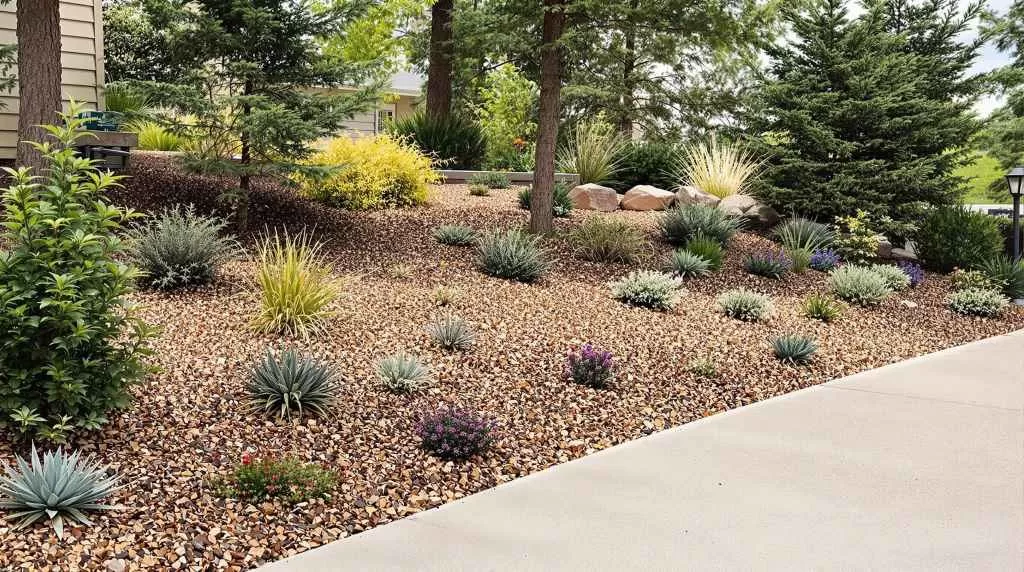
Planting with slope stabilization in mind means choosing species with deep, fibrous roots that form a web-like structure underground. These roots grip the soil and prevent it from slipping. Native grasses, ornamental varieties like blue avena or switchgrass, and low shrubs such as cotoneaster work well on Castle Pines slopes, offering both practical reinforcement and visual appeal.
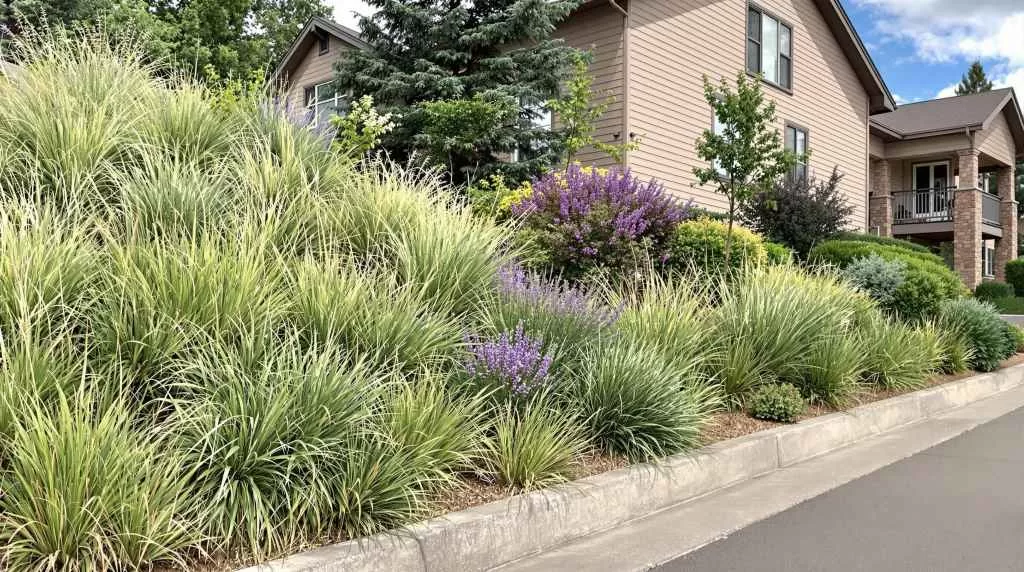
Many elevated properties in Castle Pines have rocky or compacted soils that struggle to hold water evenly. Amending these soils with organic compost, peat moss, or decomposed granite can dramatically improve water retention and promote deeper root growth. This is especially important in sloped areas, where water tends to run off before it can penetrate. By loosening the soil and enriching it with organic matter, landscapers can create conditions where moisture stays in place longer and plants can establish more effectively.
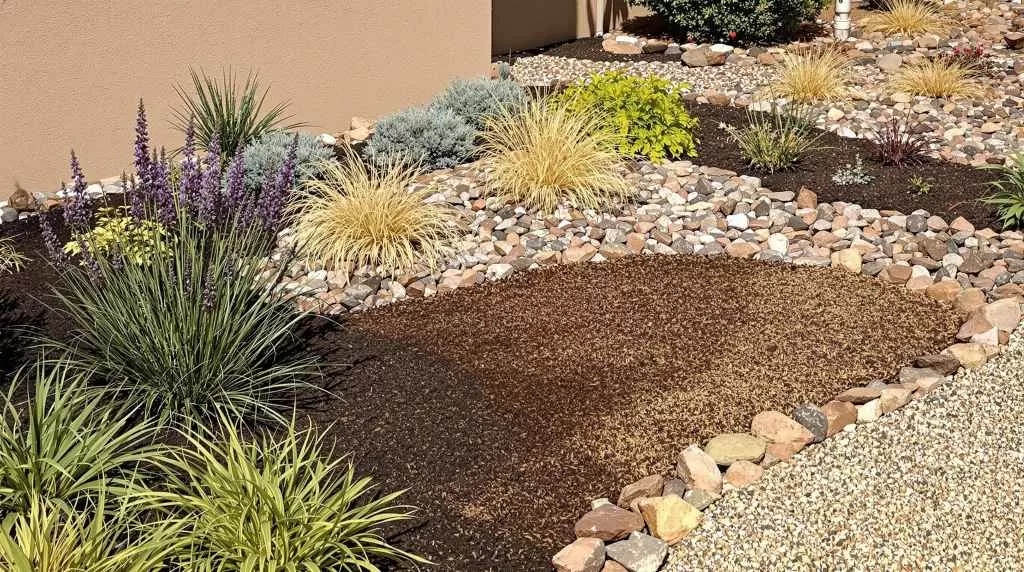
In Castle Pines, even small elevation differences—such as a gentle rise or a shallow dip—can create distinct microclimates within a single yard. These microclimates are shaped by how sunlight, wind, and moisture interact with the land’s contours. South-facing hills may be hot and dry, while north-facing slopes remain cool and damp. Recognizing and designing for these variations allows homeowners to select plants and features that are ideally suited to the specific conditions of each zone.
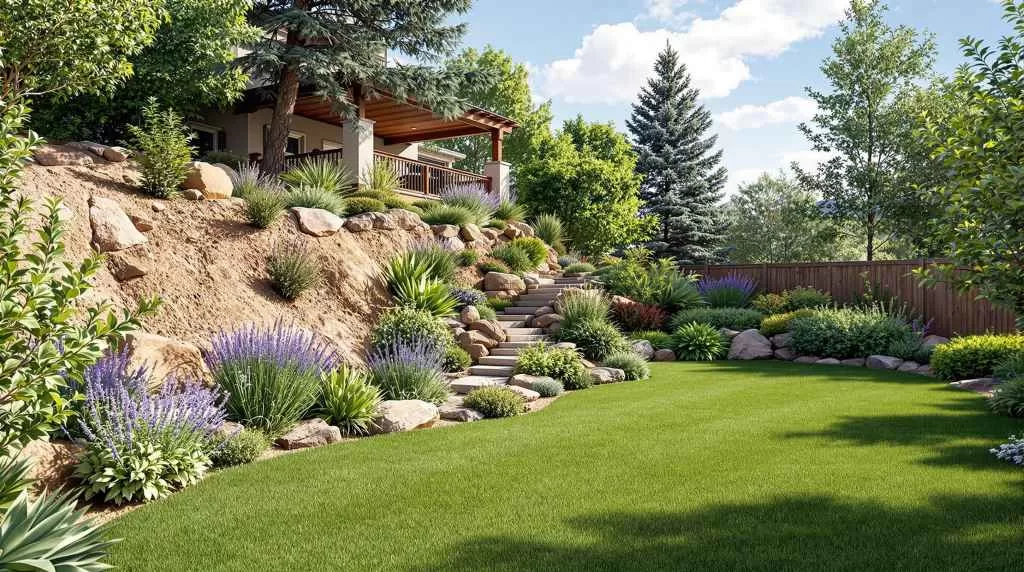
The direction a slope faces significantly alters its exposure to sun and moisture, which in turn determines the types of plants that will thrive.
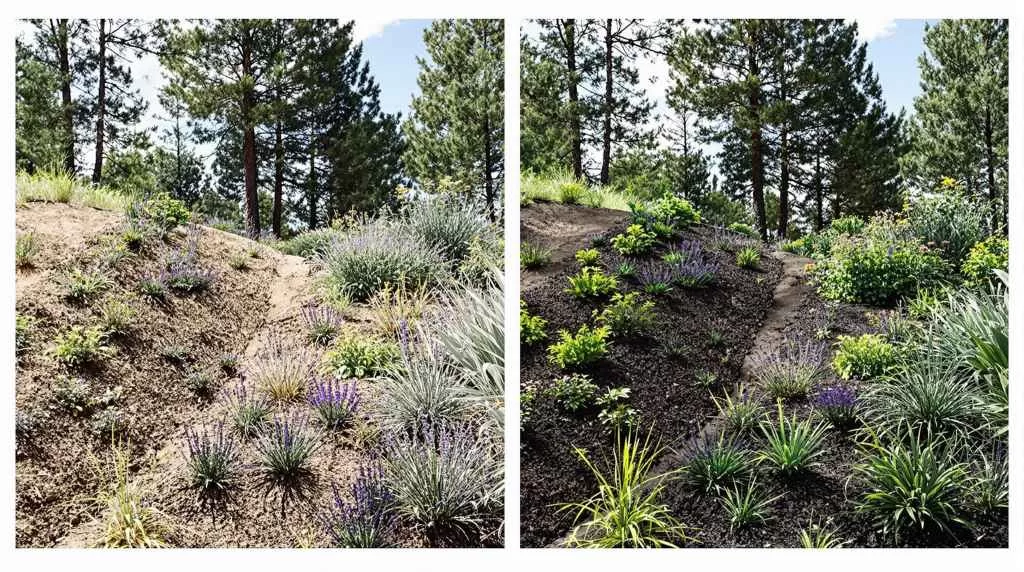
South-facing slopes in Castle Pines receive more direct sunlight throughout the day, which raises soil temperatures and extends the usable growing season in these areas. These warm microclimates are ideal for sun-loving and heat-tolerant plants like lavender, Russian sage, and salvia. The added warmth can also help marginal species survive colder months, making this slope orientation valuable for ornamental and edible gardening.
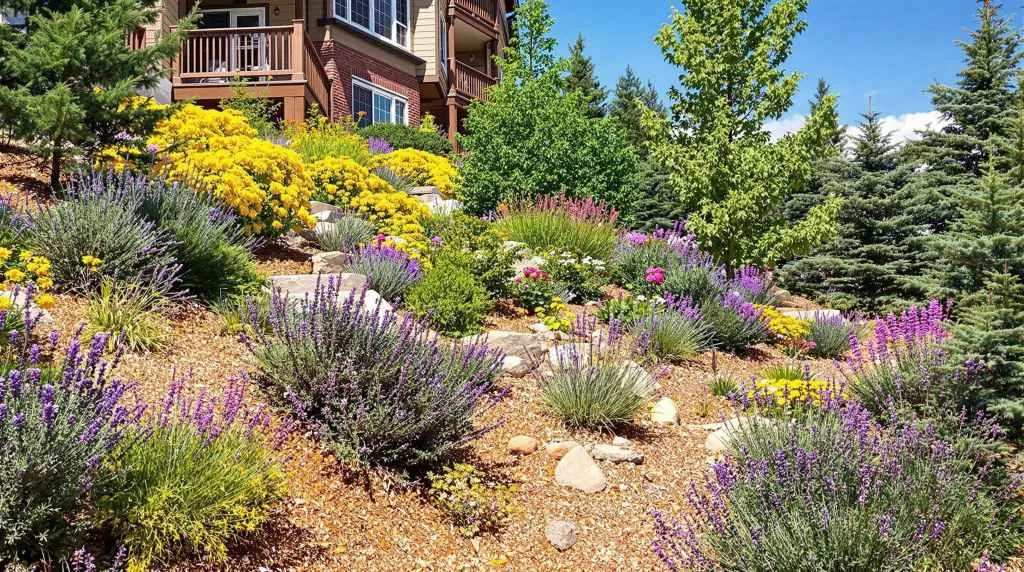
North-facing slopes receive less sun exposure, which keeps soil cooler and often retains more moisture, especially after snowmelt or rainfall. These areas are better suited for plants that prefer shade or consistent soil dampness, such as ferns, hostas, and certain groundcovers. However, extra care may be needed to prevent mildew, moss buildup, or root rot, especially in compacted soils.
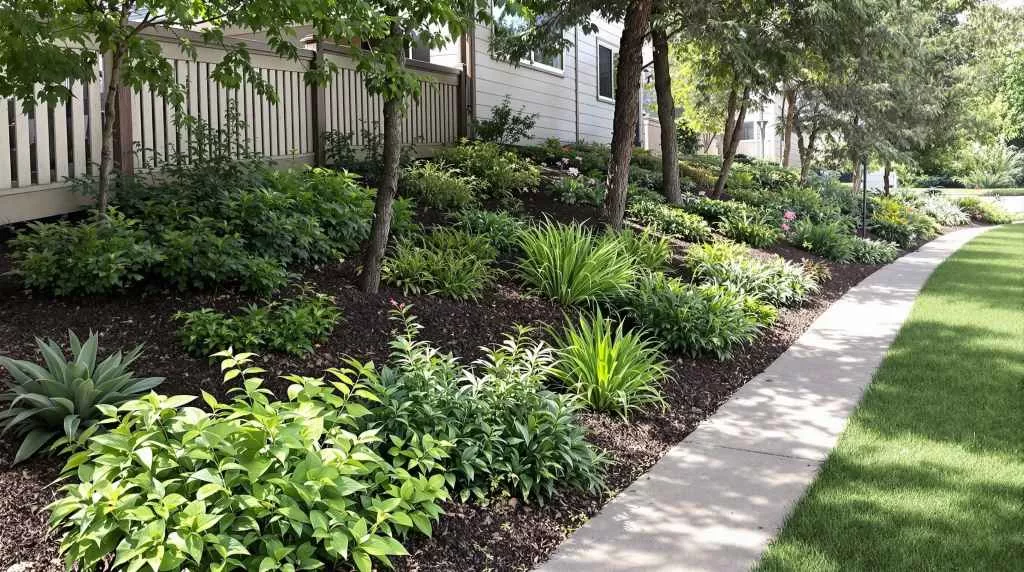
At Castle Pines’ elevation, wind can be a powerful force—especially on open, elevated lots or ridgelines. Strategically placed trees, fencing, or boulder groupings can serve as effective windbreaks, reducing plant stress and protecting outdoor living areas. Creating sheltered microzones not only improves growing conditions but also increases comfort in spaces like patios or pergolas. Thoughtful wind management helps prevent soil erosion, moisture loss, and plant damage, especially on exposed slopes. See how our Castle Pines landscape designs use natural materials to create wind-resistant outdoor zones.
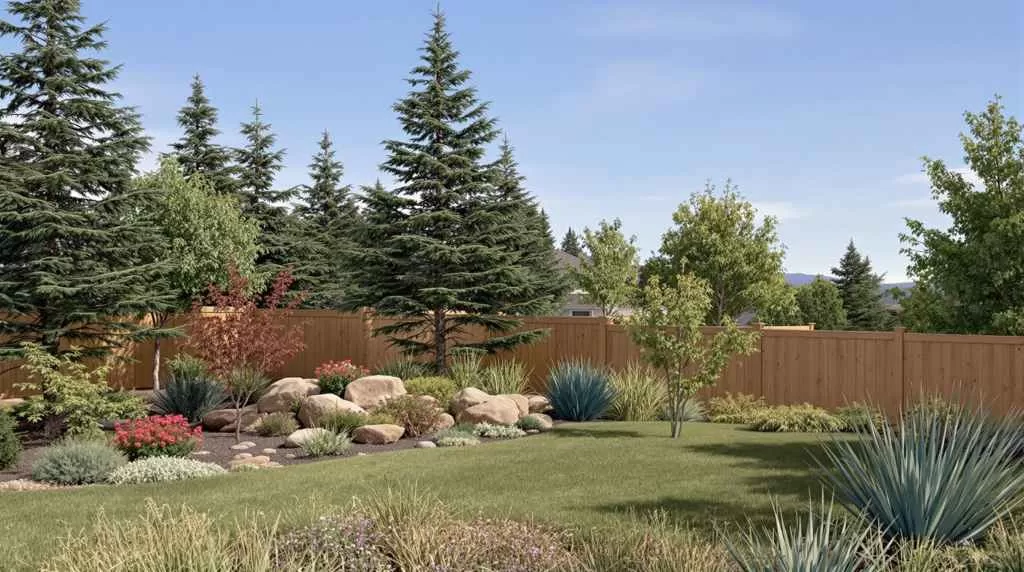
Elevated and sloped landscapes in Castle Pines require a more strategic approach to irrigation. Water tends to flow downhill quickly, often bypassing root zones and pooling in low areas, leading to dry upper slopes and oversaturated lower sections. Effective irrigation in these settings demands careful system design that accounts for gravity, soil type, and sun exposure, ensuring that every part of the yard receives the right amount of moisture without waste or runoff.
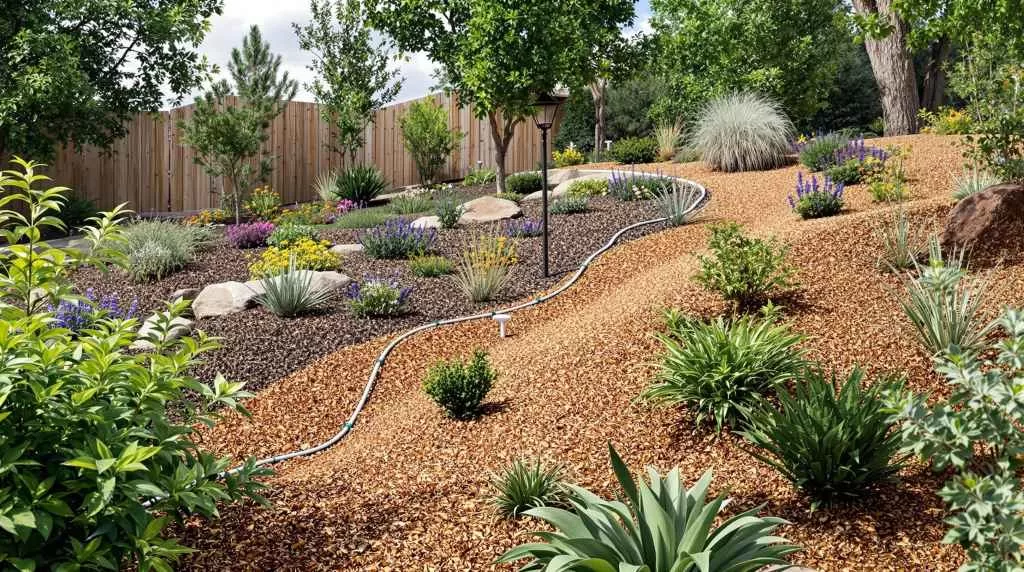
Sloped yards are especially prone to uneven watering, where the topsoil dries out quickly and the base of the slope becomes soggy. To keep moisture consistent and prevent water waste, systems need to be tailored to the slope’s layout and sun exposure.
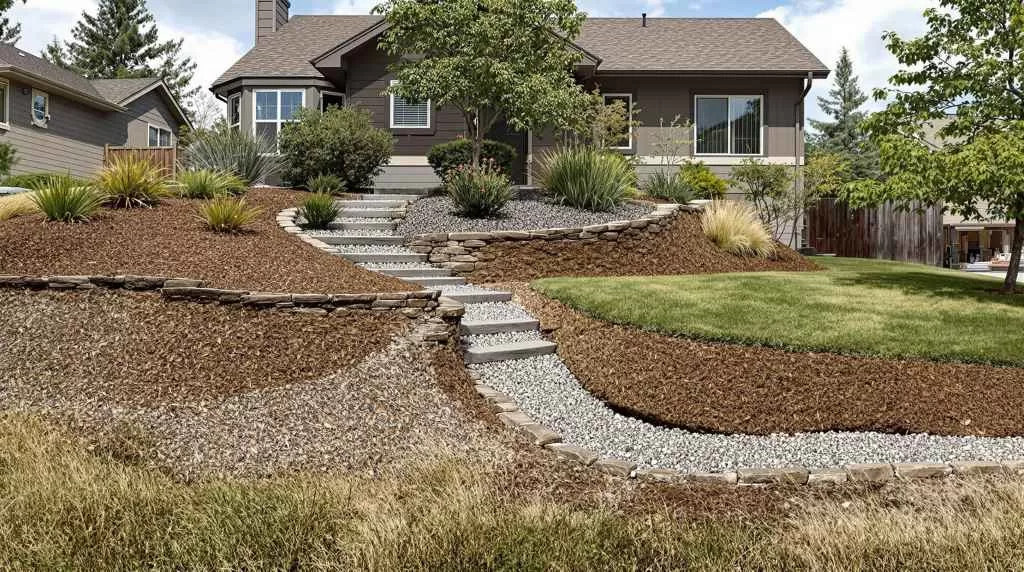
Drip irrigation is far more effective than sprinklers on sloped terrain because it delivers water slowly and directly to the root zone. This reduces the chance of runoff and allows the soil to absorb moisture more gradually. In Castle Pines, where evaporation and slope both affect water retention, low-flow drip systems are ideal for conserving water and keeping plants healthy, especially on sun-exposed south-facing slopes.
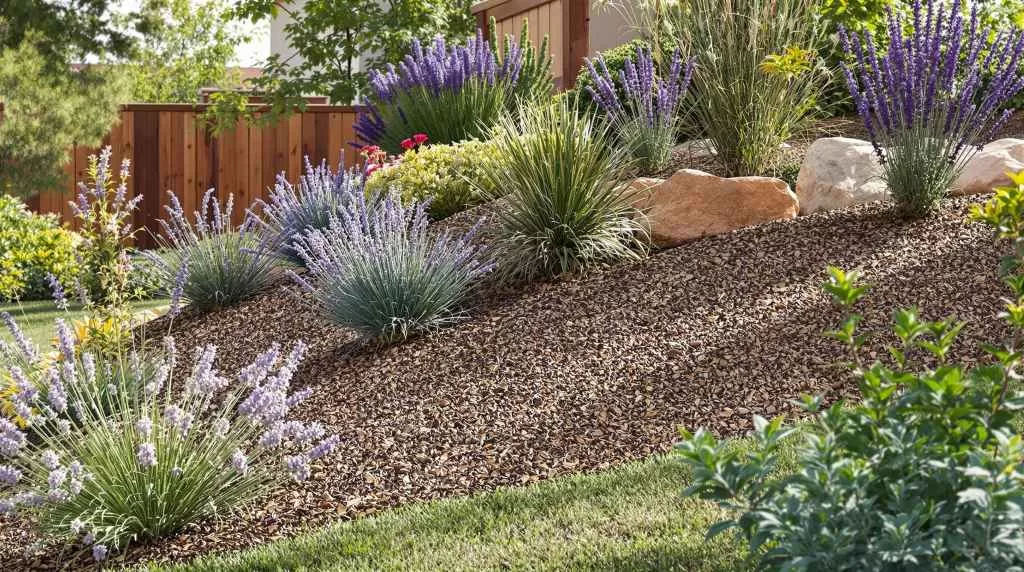
Zoning an irrigation system by elevation, sun exposure, and plant type ensures that each area receives just the right amount of water. Upper zones may require longer run times due to faster drying, while lower zones may need shorter, less frequent watering to avoid waterlogging. A well-zoned system maximizes efficiency and prevents common issues like erosion, shallow root development, or fungal growth.
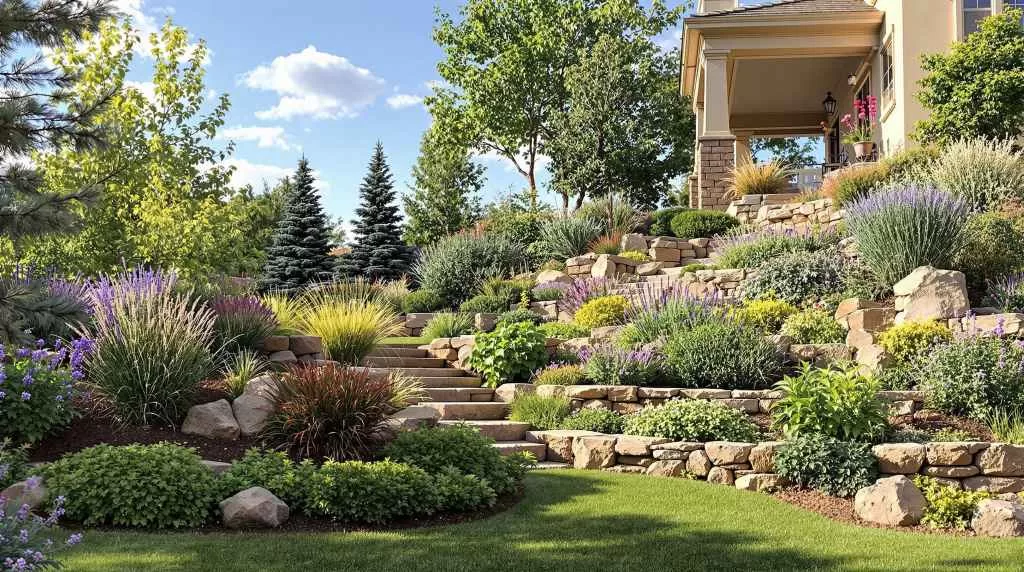
Water pressure can fluctuate significantly in elevated landscapes, especially when irrigating across different slope levels. Without regulation, downhill zones may receive too much pressure while uphill emitters underperform. Installing pressure regulators and check valves ensures consistent delivery across all zones. In Castle Pines, where elevation changes are common even within a single yard, managing water pressure is essential to maintaining a balanced and effective irrigation system.
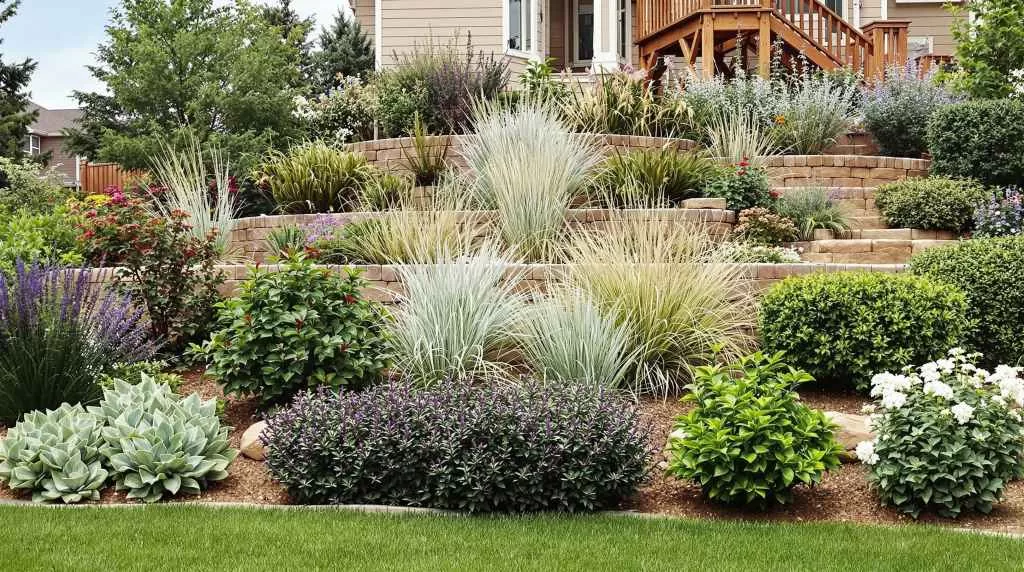
Installing hardscapes—like patios, walkways, and retaining walls—on sloped or uneven terrain in Castle Pines comes with added structural challenges. Grading, drainage, and soil stability must all be addressed to ensure that these features stay level, functional, and attractive over time. Because of the area’s elevation, freeze/thaw cycles, and soil conditions, hardscapes need extra attention to their foundation, materials, and layout to prevent long-term issues like shifting, cracking, or settling.
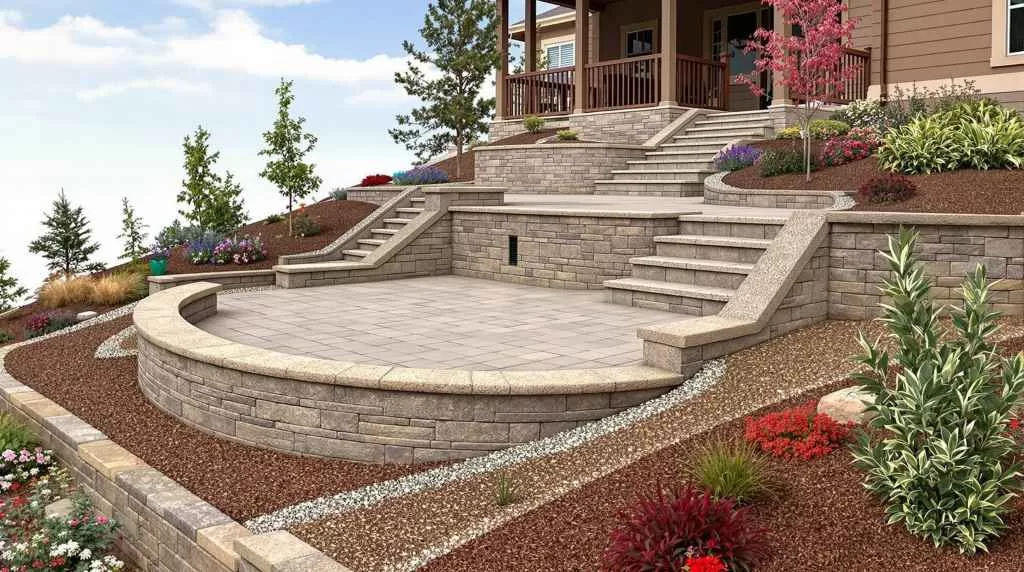
On sloped lots, the integrity of a hardscape begins with its foundation. Proper installation involves deep footings, compacted road base, and gravel layers that allow for both drainage and load-bearing stability. In Castle Pines, where soil can be clay-heavy or shallow over rock, compaction and sub-base thickness are critical to prevent movement over time. Reinforced edges, drainage channels, and sometimes even geogrid systems may be used to anchor the structure to the slope. We build long-lasting patios and retaining walls through our Castle Pines landscaping services that are engineered for elevation.
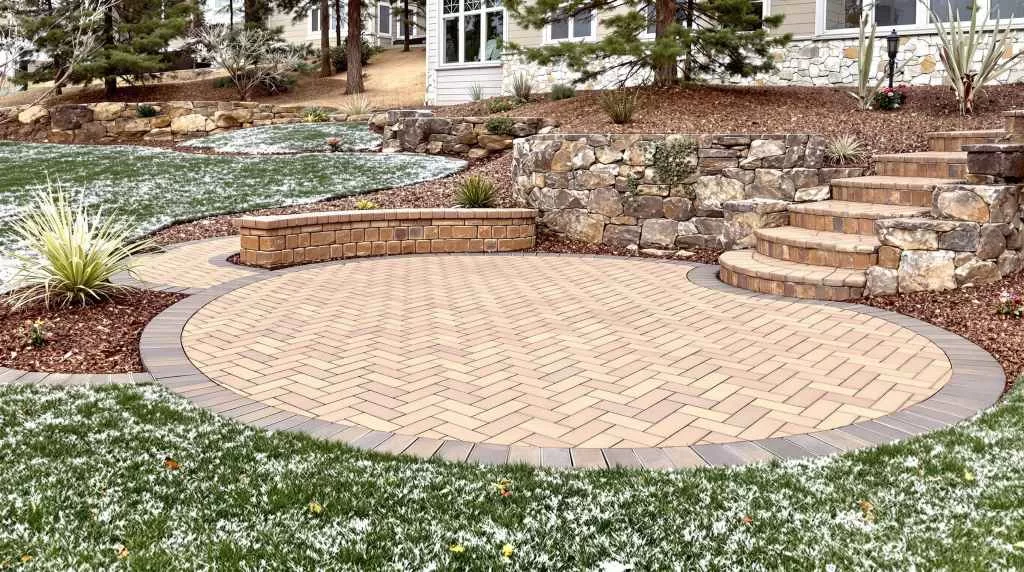
Without proper planning, elevation-related stress can cause hardscape elements to heave, settle unevenly, or pull apart—especially in winter. Addressing the underlying causes is key to long-term performance and safety.
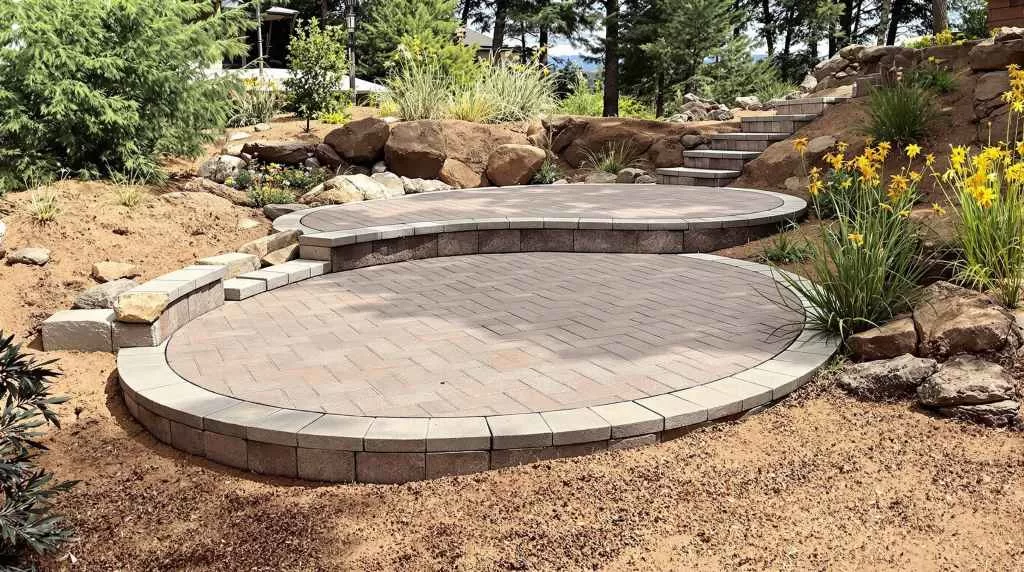
Castle Pines’ elevation leads to frequent freeze/thaw cycles that cause moisture in the soil to expand and contract, pushing against hardscaped surfaces. This is a leading cause of cracked concrete and displaced pavers. To combat this, installers should use non-porous materials where possible, avoid moisture traps under slabs, and build with proper slope and drainage to move water away before it freezes.
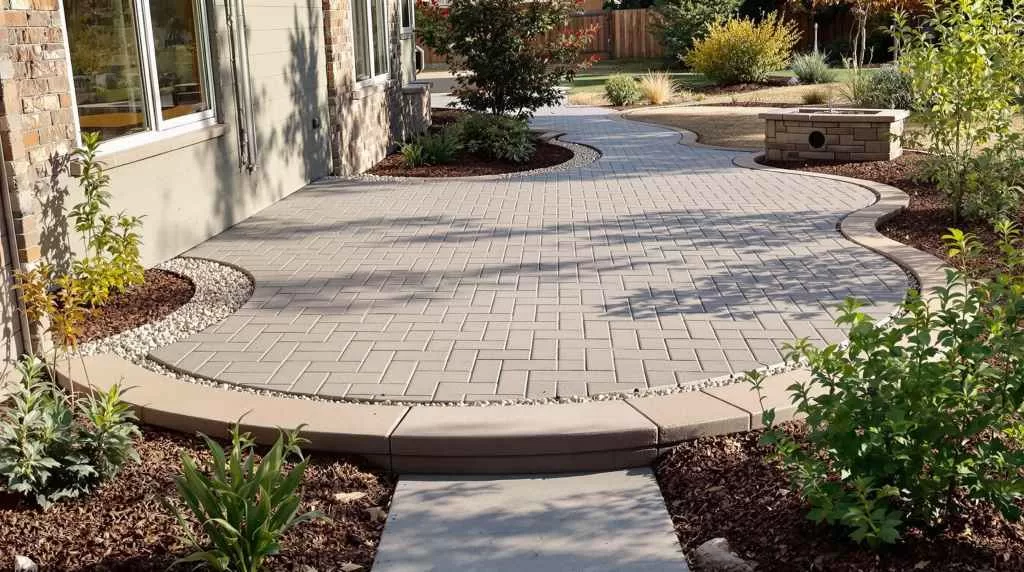
Different materials handle high-elevation stress in different ways:
Selecting the right material based on slope, exposure, and use case helps ensure your hardscapes in Castle Pines remain safe, attractive, and long-lasting.
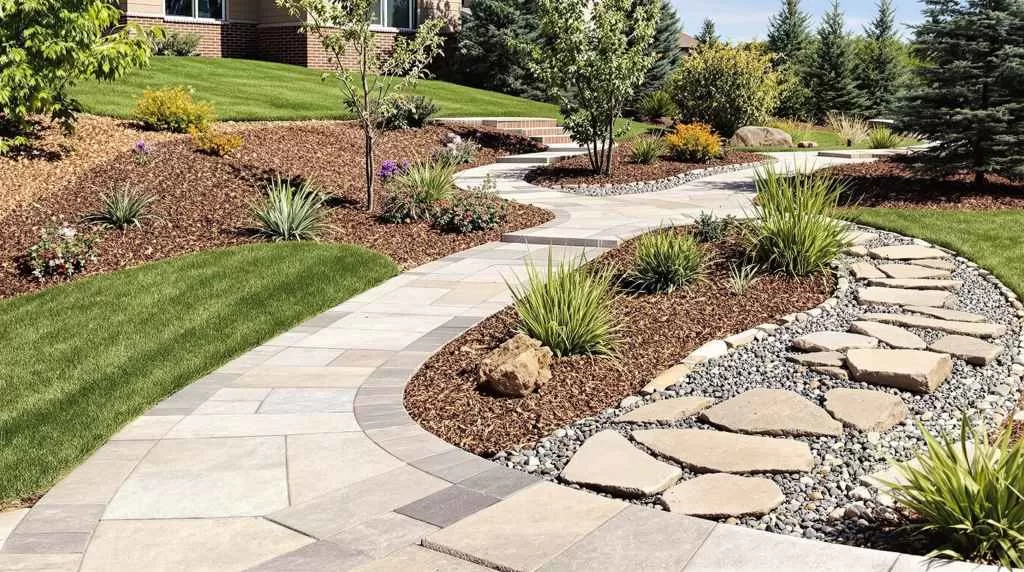
Retaining walls are essential for managing grade changes in Castle Pines landscapes, especially on properties with noticeable slope or elevation shifts. These walls serve both practical and aesthetic purposes, helping to stabilize soil, create level spaces, and define landscape zones. Whether you’re building a usable terrace for outdoor living or holding back a steep hillside, retaining walls are a powerful tool for turning elevation challenges into design opportunities.
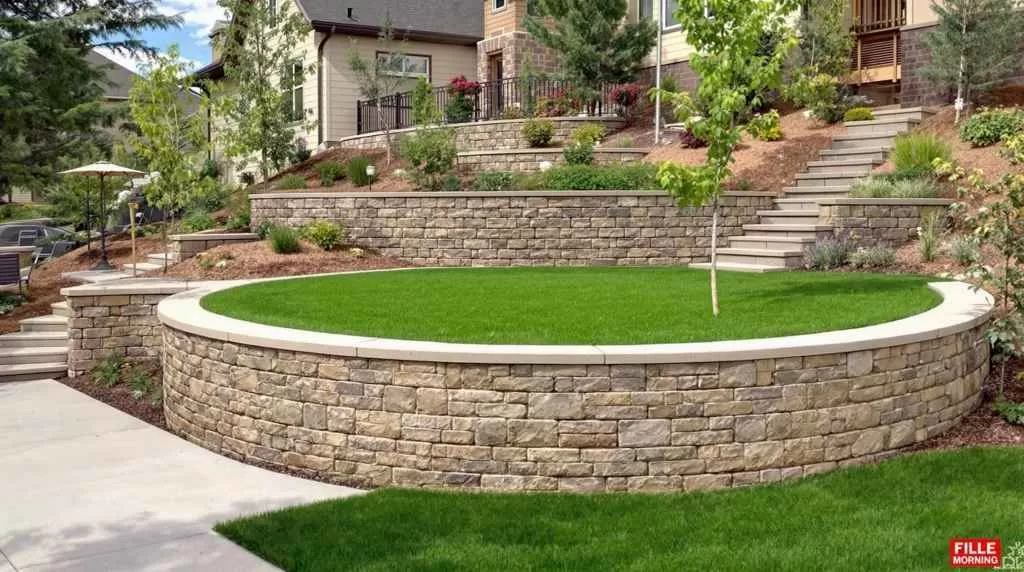
Not all retaining walls are created equal. Some are purely decorative, meant to create gentle transitions or edge features, while others are engineered to support significant weight and hold back soil. In Castle Pines, where elevation changes can be steep and soil conditions variable, understanding the difference between a load-bearing wall and an accent wall is crucial to ensuring your design performs safely and effectively.
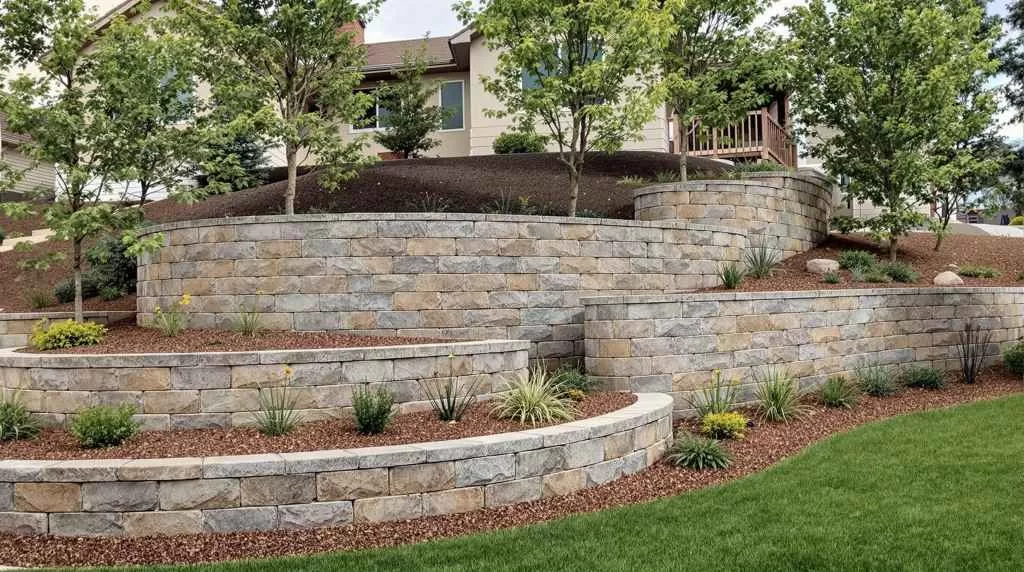
Structural retaining walls must be built to withstand lateral earth pressure and provide effective drainage to relieve water buildup behind the wall. Without proper drainage—such as gravel backfill, perforated pipe, and weep holes—water pressure can cause walls to bulge, lean, or collapse over time. Especially at Castle Pines’ elevation, where snowmelt and storms can bring sudden runoff, engineering for load and drainage is non-negotiable in wall design.
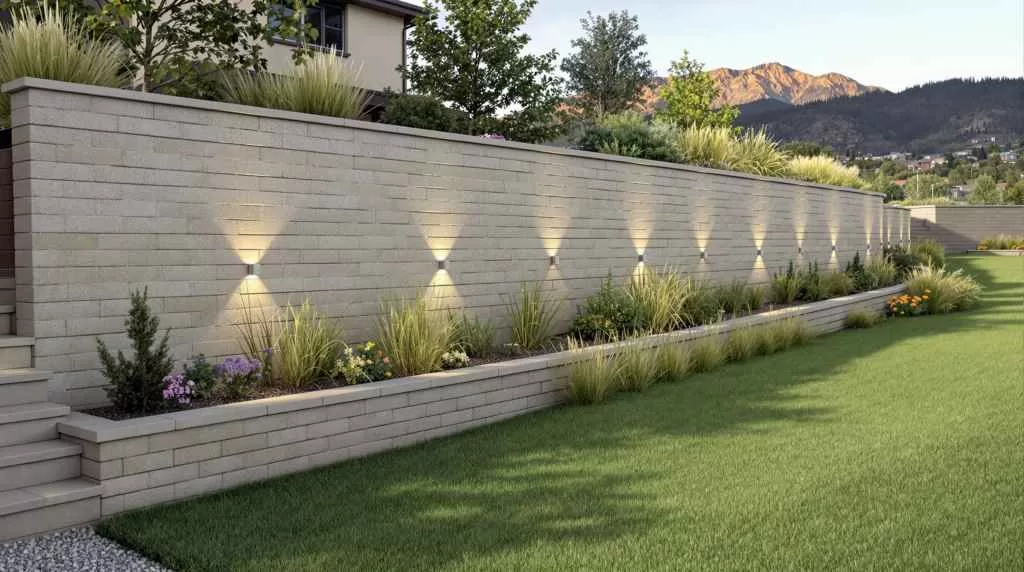
When a single tall wall isn’t ideal, multi-tiered retaining wall systems offer a visually appealing and structurally sound alternative. These stepped designs help break up the force of the slope, reduce erosion risk, and create natural levels for planting or outdoor living. In Castle Pines, tiered walls are often used to blend into the natural terrain while improving both functionality and aesthetics across steep yards.
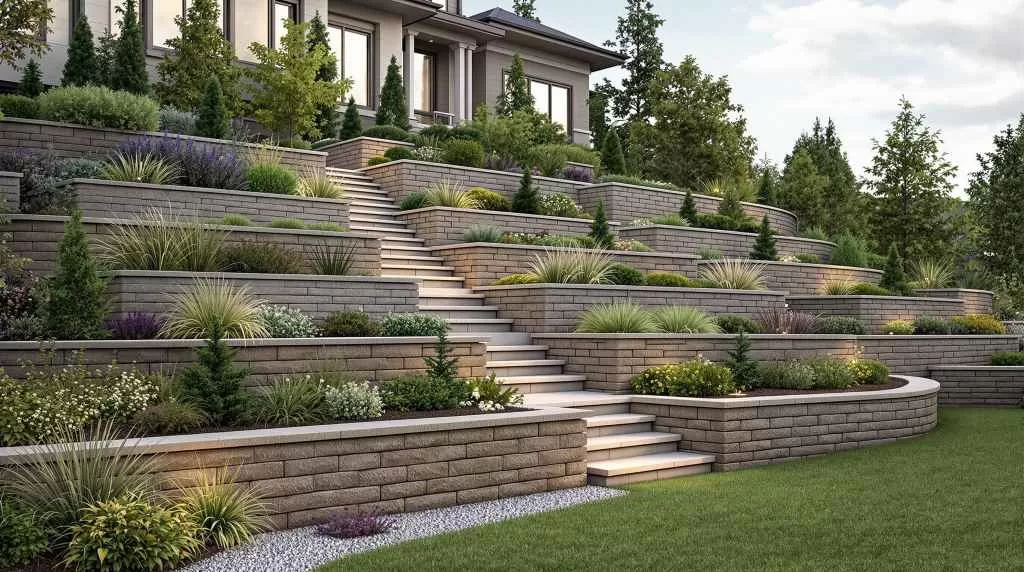
Lighting in elevated or sloped landscapes is more than just decoration—it plays a key role in safety, depth perception, and overall design cohesion. In Castle Pines, where yards often feature multi-level terrain, lighting must be intentionally planned to illuminate changes in grade, guide foot traffic, and accentuate the natural beauty of elevation. When done correctly, landscape lighting can enhance visibility on slopes while creating dramatic highlights that showcase the property’s best features after dark.
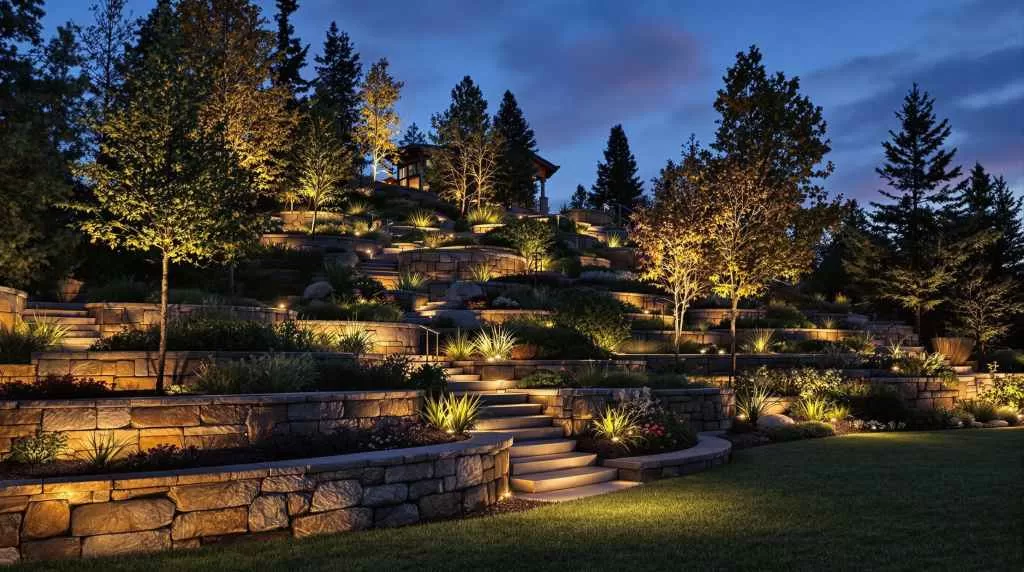
Sloped properties provide the perfect opportunity to use uplighting techniques that draw attention to vertical elements. By aiming light upward at trees, retaining walls, rock outcrops, or architectural features, you can emphasize height, create visual drama, and establish focal points that stand out at night. In Castle Pines, where elevation naturally introduces vertical layering, uplighting is a powerful tool for making the most of a yard’s dimensional character.
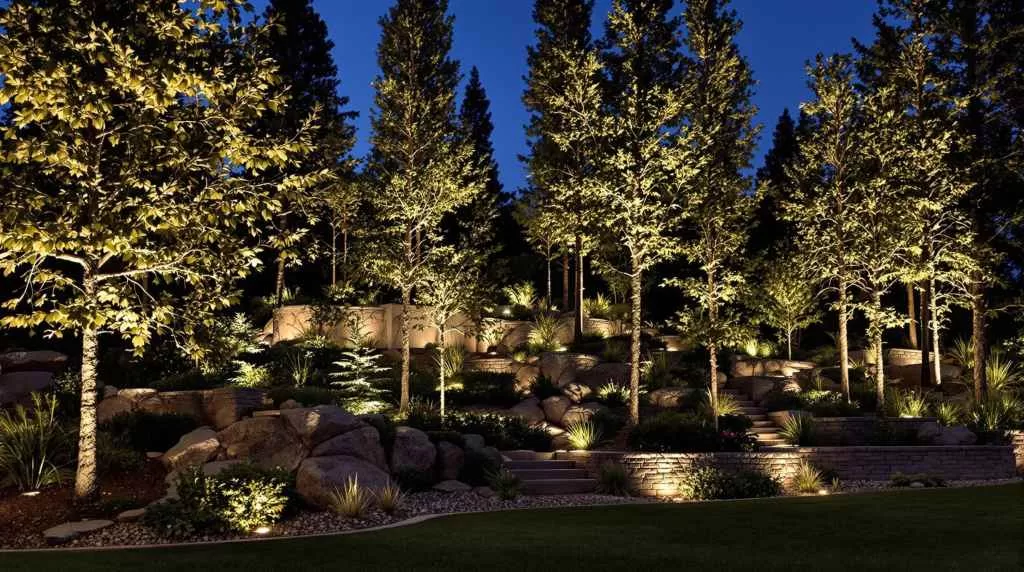
Elevation changes can unintentionally create dark zones or shadowy areas if lighting is not carefully angled. Fixtures placed too low or aimed too narrowly may leave steps, slopes, or walkways under-lit, increasing the risk of accidents. To combat this, designers use a mix of path lights, wall washes, and downlighting from above to create balanced illumination across every level. In Castle Pines, where safety and visibility on uneven ground are key, thoughtful lighting placement ensures the landscape is as functional as it is beautiful.
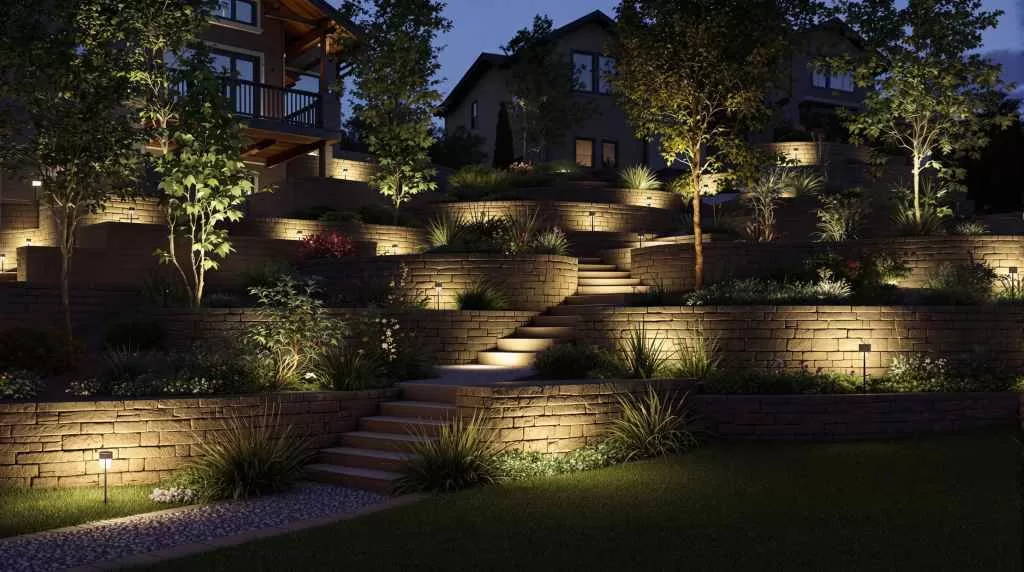
Many Castle Pines neighborhoods operate under Homeowners Associations (HOAs) that implement rules designed to protect property values, preserve views, and manage drainage across hilly terrain. These regulations are especially important in elevated areas where slopes, retaining walls, and mature trees can affect not only the aesthetics but also the functionality and safety of surrounding properties. Understanding these guidelines before beginning any landscape project ensures compliance and helps avoid costly rework or penalties.
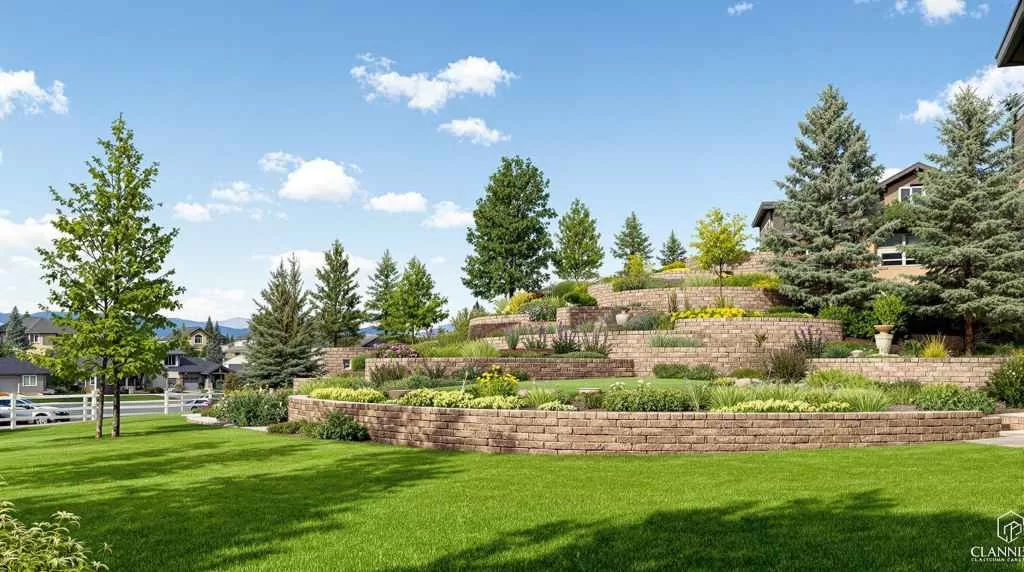
Castle Pines HOAs often include view corridor protections, particularly in communities with scenic overlooks or ridgeline properties. Homeowners may be required to limit the height of trees, shrubs, or built structures that could obstruct neighboring views. These rules help maintain the open, expansive feel of the area while encouraging the use of strategically placed low-profile plantings or trimmed tree canopies to achieve privacy without sacrificing sightlines.
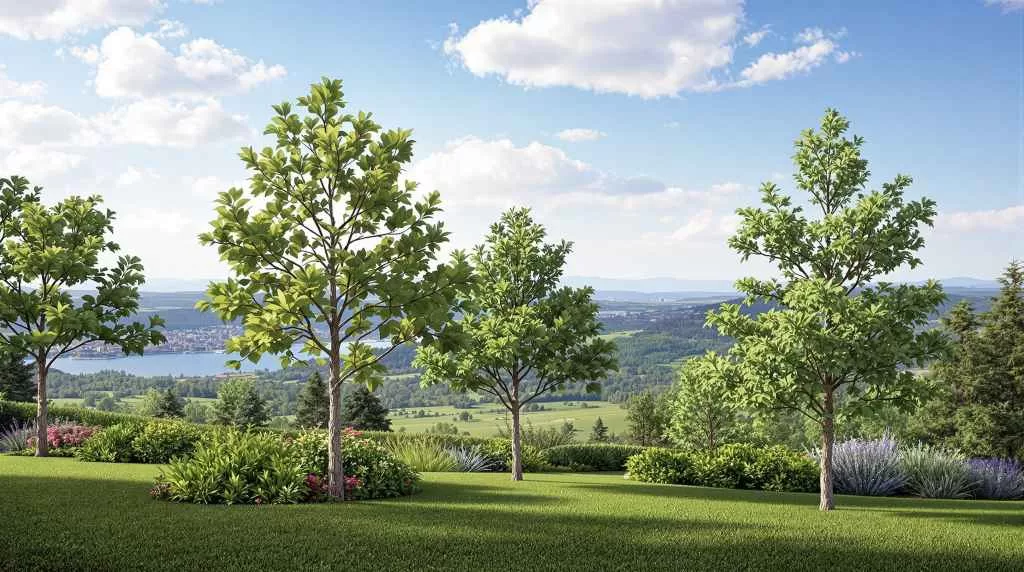
Because of the town’s elevation and sloped landscapes, HOAs place strong emphasis on managing stormwater and runoff. Homeowners must implement approved grading and drainage systems that prevent erosion, standing water, or redirected flow onto adjacent lots. This often includes requirements for retaining wall drainage, permeable paving, or swale systems. Ensuring proper runoff control is not only an HOA requirement—it’s essential for protecting neighboring properties and maintaining slope stability throughout the community.
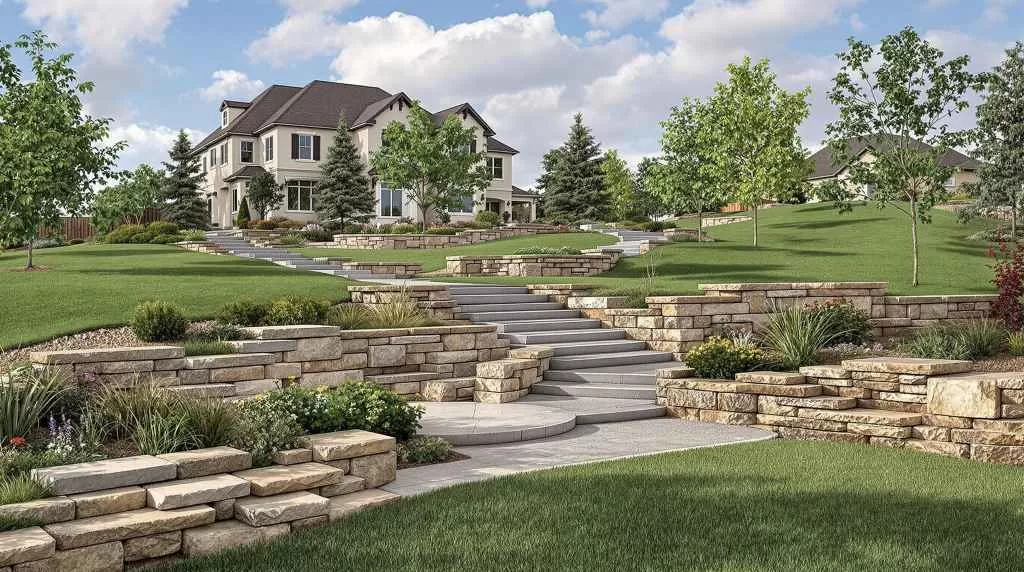
Rather than leveling or reshaping the land, many Castle Pines homeowners are choosing to work with the existing terrain to create landscapes that feel natural, functional, and beautiful. Embracing the grade not only reduces excavation costs and environmental disruption but also leads to designs that highlight the land’s natural character. By letting the slope guide the layout, you can create outdoor spaces that blend seamlessly into the surroundings and require less maintenance over time.
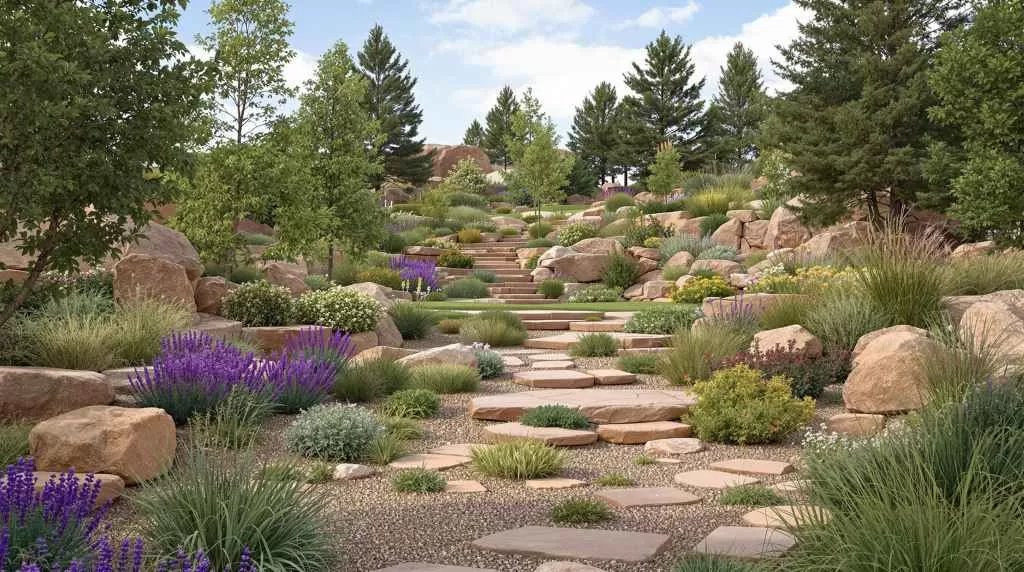
One of the most effective ways to design with the slope is to use materials and elements that follow the contours of the land. This includes:
These choices help the landscape feel organic while also reducing the need for constant upkeep.
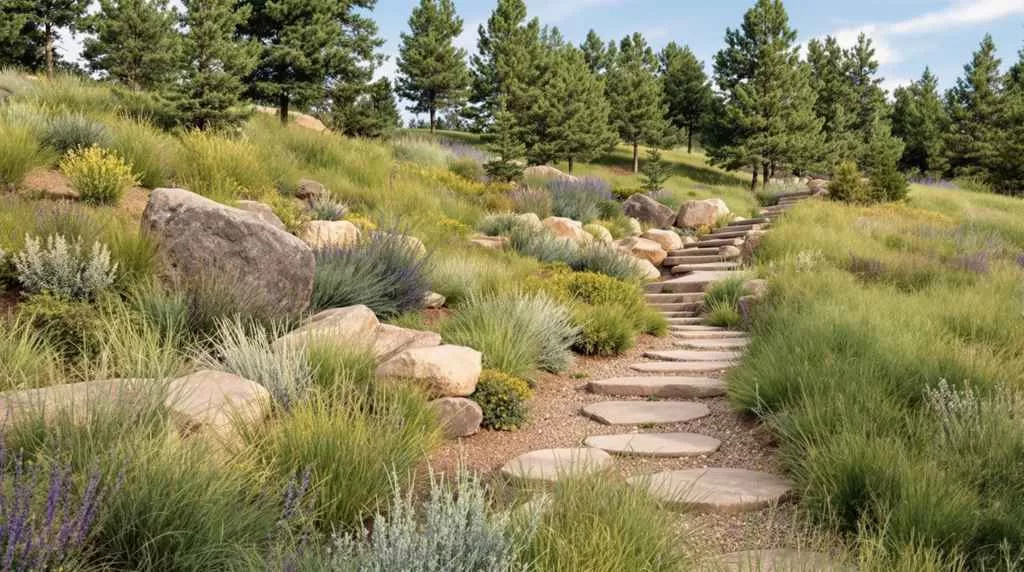
Sloped landscapes offer a unique opportunity to create multi-dimensional plant arrangements that wouldn’t be possible on a flat lot. Layering different plant heights—from low groundcovers to mid-size shrubs and taller focal points—can create tiered planting beds that bring dynamic visual movement to the yard. This height variation not only enhances curb appeal but also allows you to define zones within your outdoor space, such as entryways, entertainment areas, or privacy buffers.
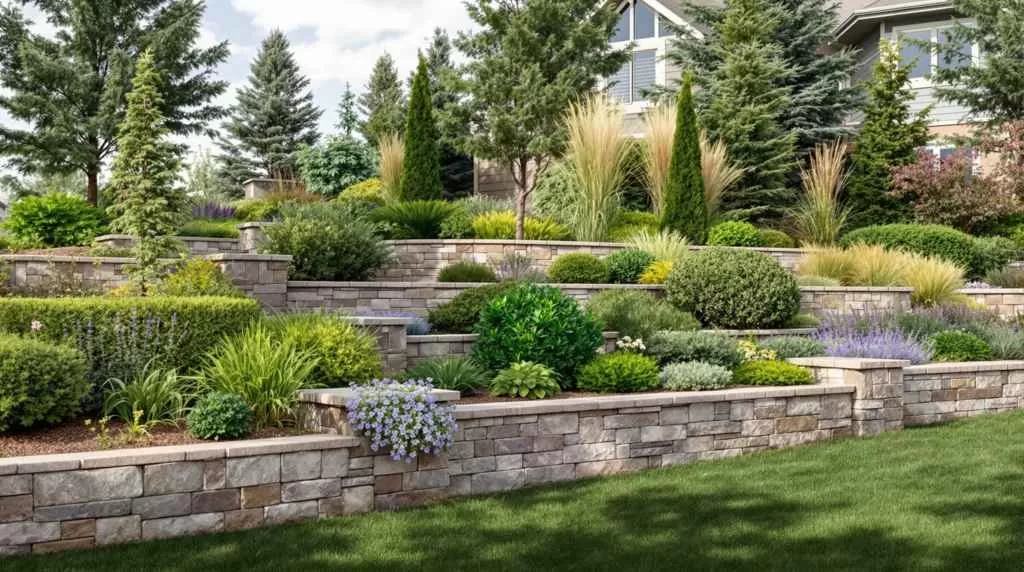
Landscaping in Castle Pines means balancing high-elevation challenges with the natural beauty that comes from living above the plains. By selecting the right plants, managing slopes intelligently, and working with the existing grade, homeowners can create outdoor spaces that are not only visually stunning but also built to thrive long-term. Whether you’re battling runoff or designing around a hill, Castle Pines offers the chance to create a landscape that feels both grounded and elevated—in every sense of the word. Ready to elevate your yard? Explore our Castle Pines landscaping solutions designed for beauty and function at altitude.

Introduction Choosing the right mulch is more than just a visual decision — it’s a key part of protecting your plants, conserving water, and keeping
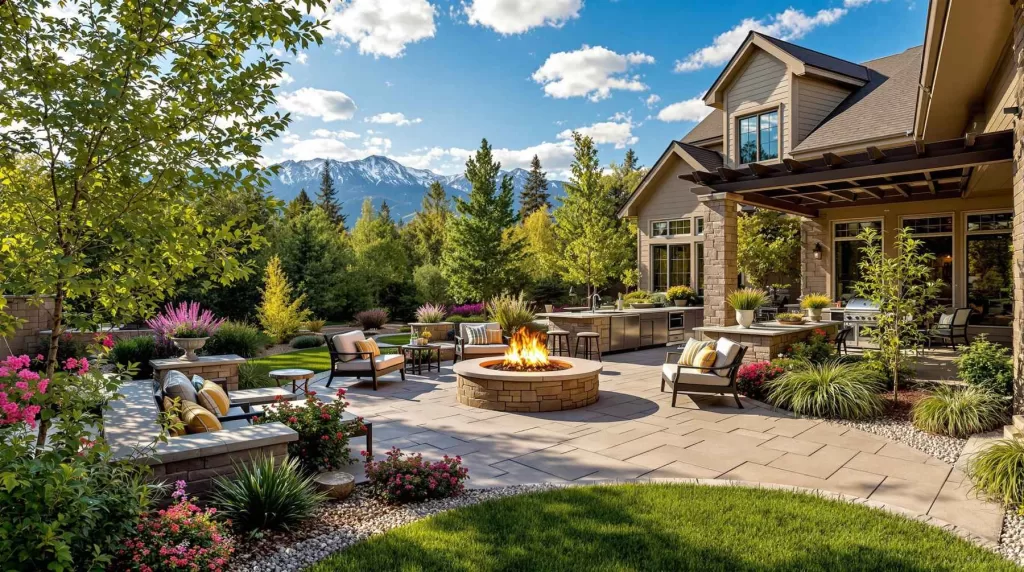
Introduction Castle Pines is home to some of the most breathtaking properties in Colorado — and luxury homeowners here expect nothing less than perfection in
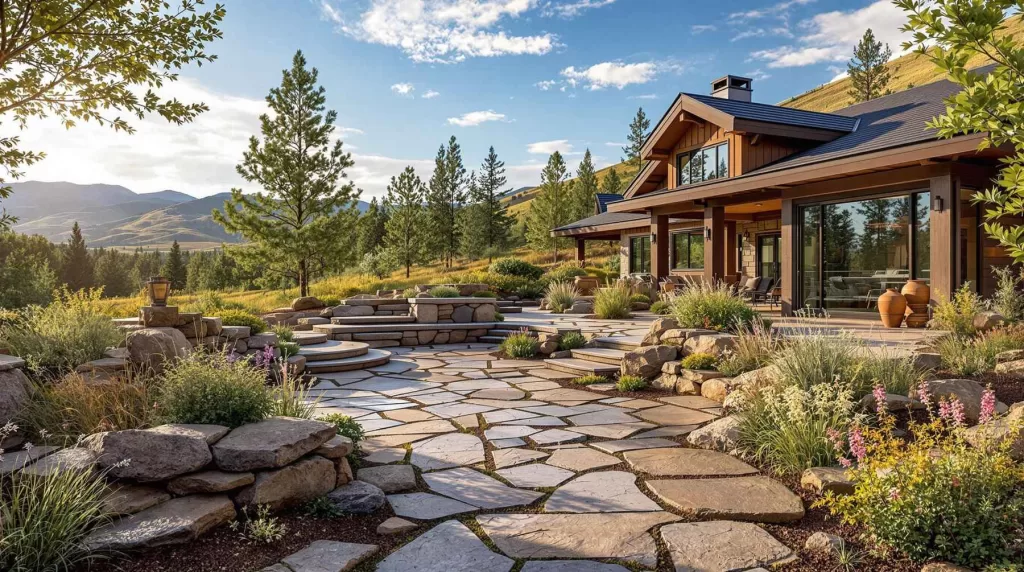
Introduction Natural stone has long been a favorite among Colorado homeowners for its durability, timeless appeal, and ability to blend seamlessly into natural surroundings. In
Fill out your details below and we will reach out to you for a free consultation!
Monday 9 AM – 5 PM
Tuesday 9 AM – 5 PM
Wednesday 9 AM – 5 PM
Thursday 9 AM – 5 PM
Friday 9 AM – 5 PM
Saturday: By Appointment Only
Sunday: Closed